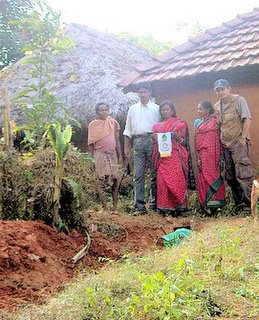 A women carries her daily requirement of firewood from the similipal hills. This dependence can be reduced by providing them with alternative green fuel solutions like the bio gas system.
A women carries her daily requirement of firewood from the similipal hills. This dependence can be reduced by providing them with alternative green fuel solutions like the bio gas system. 
We abuse land because we regard it as a commodity belonging to us. When we see land as a community to which we belong, we may begin to use it with love and respect.
 This is a tribal kitchen supplied with biogas. The biogas is produced by the polythene bio gas digester installed outside their kitchen. The biogas digester is supplied with animal manure that the beneficiary collects from his livestock. Biogas is a clean, green fuel. It improves the health of people using it as it does not produce smoke or soot. It also reduces the greenhouse effect by digesting the manure in an anaerobic(without oxygen) condition. The by-product of the bio gas unit is very high quality fertilizer, which is used by the locals to suppliment their farming needs.
This is a tribal kitchen supplied with biogas. The biogas is produced by the polythene bio gas digester installed outside their kitchen. The biogas digester is supplied with animal manure that the beneficiary collects from his livestock. Biogas is a clean, green fuel. It improves the health of people using it as it does not produce smoke or soot. It also reduces the greenhouse effect by digesting the manure in an anaerobic(without oxygen) condition. The by-product of the bio gas unit is very high quality fertilizer, which is used by the locals to suppliment their farming needs. 
 A typical kitchen in a tribal household. Conventional kitchens use firewood for cooking which produce lot of smoke and soot. It directly affects the lungs and the eyes of people in the kitchen. Women and the children are the worst affected, as they spend most of the time in the vicinity of the kitchen. It also increases the greenhouse effect on the global level, and depletes the forest resources, as the firewood comes from the adjoining forest.
A typical kitchen in a tribal household. Conventional kitchens use firewood for cooking which produce lot of smoke and soot. It directly affects the lungs and the eyes of people in the kitchen. Women and the children are the worst affected, as they spend most of the time in the vicinity of the kitchen. It also increases the greenhouse effect on the global level, and depletes the forest resources, as the firewood comes from the adjoining forest. 
 Beneficieries with the benefactors banner next to the Biogas plant installed by GreenPower Canada and Greenpower India along with WWF,Orissa and MBR, Baripada.
Beneficieries with the benefactors banner next to the Biogas plant installed by GreenPower Canada and Greenpower India along with WWF,Orissa and MBR, Baripada. 
 The beneficiaries of Unit 1
The beneficiaries of Unit 1
 This is what we want to reduce !
This is what we want to reduce !